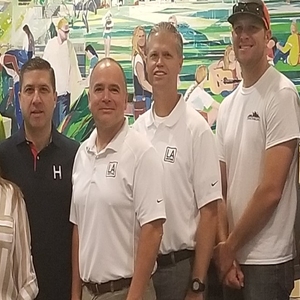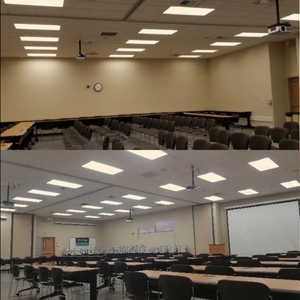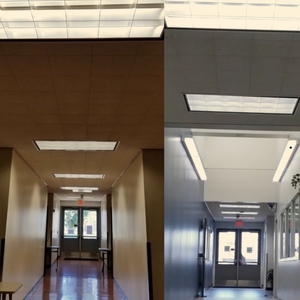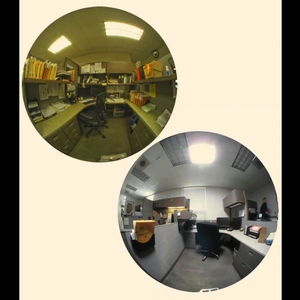San Bernardino Community College’s Journey to sustainability and achieving Zero Net Energy
Arup, San Bernardino Community College District
Project Overview
In San Bernardino Community College District (SBCC) pursuit to lead the journey in sustainability, SBCC committed itself back in 2010 to a “Sustainability Plan”. This commitment started at its Crafton Hills College, where a 1.3 MW solar tracking system was built. Its next step included transforming the parking lot of the District Office and Advanced Technology Training Center to include a solar carport, which also produces 170 kW of clean renewable energy. SBCCD believes in best practices and is determined to lead other districts to a clean energy future for this generation and future generations by retrofitting each of its facility’s energy needs and prove that it can achieve Zero Net Energy (ZNE). SBCCD developed a pilot program to determine the feasibility of achieving ZNE to benefit its campus and community by working with its collective leadership, facility department, and external innovative partners in realizing a number of project successes, including replication of these pilot projects for future development. These project successes include the integration of solar tubes, LED lighting, advanced lighting controls, high efficiency HVAC and the solar PV canopy. SBCCD has committed “walking the Walk” in becoming an environmental stewardship by developing and committing to its “Sustainability Plan.”
SBCCD is proud to be the first and only CCD in Southern California to be a part of Proposition 39 ZNE Schools Pilot Program. SBCCD’s commitment to creating a campus wide culture of sustainability, and energy efficiency resulted in directing needed funds and resources to this effort in becoming a ZNE prototype Community College District. To serve the schools community more broadly, the IOUs involved in this Pilot program will disseminate learnings, processes and materials germane to ZNE amongst the many stakeholders in the California schools community. These ongoing efforts involve training classes, webinars, publications, design guides and recognition events as information vehicles. The IOUs will learn from the Pilot to explore the feasibility of a larger-scale program development for future years. Taken together, the Pilot efforts are intended to address ZNE needs in schools and community colleges on a comprehensive and sustainable basis though the duration of Prop 39 and beyond.
ZNE for schools is the next evolution in sustainable, high performance buildings. It not only helps to create comfortable and a productive environment for teachers and students, but it also helps gather informative, unspoken areas like current cost of ZNE for school districts, and how these barriers can be driven down.
Background
The Proposition (Prop) 39 ZNE Schools Pilot (Pilot) will assist schools and community colleges in retrofitting existing facilities to zero net energy (ZNE) by leveraging Prop 39 funding. The goal of this activity will be to establish “proof of concept” that ZNE retrofits of schools is feasible across California.
Pacific Gas and Electric Company (PG&E), San Diego Gas and Electric Company (SDG&E), Southern California Edison Company (SCE), and Southern California Gas Company (SoCal Gas) (together the “Investor-Owned Utilities”, or “IOUs”) were tasked to administer this ZNE Pilot effort and select potential school districts to participate in the Pilot Program.
IOUs targeted approximately 13-18 school districts or community colleges with this effort. Additionally, to serve the schools community more broadly, the IOUs disseminated learnings, processes and materials germane to ZNE amongst the many stakeholders in the California schools community. These ongoing efforts involve training classes, webinars, publications, design guides and recognition events as dissemination vehicles. Finally, the IOUs will learn from the Pilot to explore the feasibility of a larger-scale program for future years. Taken together, the Pilot efforts are intended to address ZNE needs in schools and community colleges on a comprehensive and sustainable basis though the duration of Prop 39 and beyond.
“A ZNE building generates as much energy as it consumes annually. Each year our schools spends more than $6 billion on energy. This is second only to salaries and more than textbooks and computers combined!* ZNE saves energy and puts money back into classrooms.”
After a two-phase application and screening process SCE and SOCALGAS, approved the SBCCD application to participate in their Prop 39 ZNE Pilot program. The pilot program sought to retrofit existing SBCCD’s facilities to achieve an extremely low energy footprint, in the range of 16–22 kBtu/sq.ft.-yr at the site, considered sufficiently low to ensure that the smallest (and therefore least costly) renewable energy system can be used to achieve ZNE.
SCE selected Cadmus as a consultant to provide the necessary support services to identify, determine the feasibility of, and facilitate the implementation of energy efficiency measures (EEM) at the SBCCD facility, seeking to achieve ZNE. A separate consultant, Noresco, was retained to conduct measurement and verification (M&V) to confirm that the facility achieves ZNE, based on one year of post-retrofit monitoring. Starting Jan 2019, M & V process has begun.
Goals
Goal One- Establish Proof of Concept: The Pilot program aims to establish “proof of concept” that ZNE retrofits of schools is feasible across California.
Goal two - Learn best methods to implement ZNE: All stakeholders involved in this Pilot program are receiving an in-depth training on ZNE design, implementation and sustainability. The information gathered on any challenges on building to a ZNE level, is the basis of case studies being developed for school district education. This project presented unique challenges as the energy efficiency measures proposed would need to be implemented during normal working hours, within a very aggressive time period to complete and strict budget constraints.
Goal three – Monitor performance of the building to make sure proposed measures are effective and the building will achieve ZNE at the end of one (1) year monitoring period.
Goal four-Duplicate the process at other campuses: The pilot program will provide the basis of larger scale implementation of ZNE concept at schools and community colleges making them stronger, resilient and energy independent.
Goal five- What is the cost of higher efficiency – We have gathered information about the current incremental cost of ZNE for school districts, and where these costs can be driven down further, allowing unspent funds to be invested in renewable energy and energy efficiency programs instead of paying for utility bills
Implementation
Using the LEED implementation process as a driver, the District has implemented a number of innovative sustainable solutions:
• SBCCD’s pathway started with a sustainability masterplan, setting out its vision and framing its approach and has led to this point in time where it now has innovative sustainable infrastructures, a large number of LEED accredited buildings – including two at the Platinum level. • A 1.3 MW solar tracking system produces clean renewable energy that offsets energy consumed by all of the new bond funded buildings at Crafton Hills College.
• A new efficient central utility plant incorporates best in class equipment efficiencies and also employs a large thermal energy storage system that is able to shift cooling energy to nighttime when ambient air is cooler and is more abundant.
• SBCCD implemented a range of water conservation measures including connections to a municipal recycled water systems.
• SBCCD continued its committed to a clean energy future for this generation and next generations by retrofitting their District Office and Advanced Technology Training Center by adding Solar Photovoltaic (PV) technology. This project also employs solar tubes, LED lighting, advanced lighting controls, high efficiency HVAC and a 170 kW solar PV canopy.
Collaboration Team: • These stakeholders are collaborating in this multi-faceted project, demonstrating success toward project goals: • SBCCD, the facility owner, a key entity and early adopter of new technologies and ETs, participant to achieving ZNE in a school retrofit setting • SCE’s Emerging Products (EP) group program, leveraging resources to investigate EE opportunities and providing overall program guidance and project funding • SoCalGas, providing gas technical support and co-funding of Prop 39 ZNE Pilot Project along with SCE • SCE’s Engineering Project Management, providing technical SMEs and technical project management to support the project throughout the design and construction process • SCE’s Pilots and Programs, providing contract management support for project costs and co-funding • SCE’s Engineering/Technical Consultants, to prepare the Design Report that identifies the energy efficiency measures best suited and recommended for the project, also to collect and analyze data demonstrating project performance; • Cadmus – Project Design Report Consultant • Agile Environments (Cadmus Lighting Specialist Sub-Consultant) • Noresco – M&V and Final Report Consultant • SBCCD’s Architectural and Engineering Consultants, translating Design Report concepts/recommendations/ideas into construction documents; • ARUP – Sustainability and Energy Consultant • HMC Architects • ENGIE (Mechanical Consultant) • SBCCD’s Contractors, executing the work according to the concepts and designs for the project and implementing and learning new technologies along the way; • Three Peaks Corporation/Titan Electric (Electrical/Lighting Contractors) • SDSTATURE (Tubular daylighting device Contractor) • LA Air-conditioning (Mechanical Contractor) • Sunbelt Controls (HVAC Direct Digital Controls Contractor) • Lemay Construction (Plumbing Contractor) • ACH Mechanical Contractors + Noresco (M&V Mechanical Contractors) • Awesome Blinds (Automatic Shading Contractor) • SBCCD Inspector, Dave Fenderson (Knowland Inspection) • Product Manufacturers, providing technical guidance and expertise on advanced technology products; • EnOcean (Wireless Controls) • LA Lighting Mfg. Co. (LED Retrofit Kits and new LED lights) • Solatube (Tubular Daylighting Devices) • Integrated Comfort Inc. (A/C Unit Pre-Coolers) • Automated Logic Corporation (HVAC Direct Digital Controls) • Trane Air-conditioning Co. (District Office Ultra High Efficiency A/C units) • Sigler (Carrier ATTC High Efficiency A/C units) • MechoShade and ThermeShade (Automatic Shading Devices) • Navien (Tankless Instantaneous Gas Water Heater) • Onset Computer Corporation (M&V Hardware) • SCE’s Testing Lab, to test proposed new technologies, i.e. custom LED lighting retrofit kits • SCE’s BCD Field Engineers, to install pre-monitoring data logging equipment at the site for baseline data
Timeline
Describe how long this project took from start to finish and provide a list of key project milestones in chronological order. • Project implementation began on June 08th, 2018 during the time that staff were on 4/10 schedule. During this time project team worked all weekends and nights, and were able to install 550 new light fixtures in one month. The balance of the projects continued during nights and weekends for the entire year of 2018/2019. • Starting Jan 2019, M & V period has begun.
Financing
Describe the costs (both upfront and recurring) for each component of the project and explain how the project was financed. Funding sources to implement these projects came from:
1) Proposition 39 initiative
2) State fund block grants
3) ZNE Pilot allocated up to $300,000 for implementation of these measures, which is 14% of the cost.
Results
1) Successfully installed various efficiency and renewable energy measures that will help the project achieve its ZNE goal.
a. Current M&V system installed through continuous diagnostics is optimizing further operation of HVAC system and Controls.
2) Raised awareness around sustainability and energy conservation for District staff.
a. ZNE promotes true “market transformation” for the School District.
3) Significantly improved lighting quality within the building, which should result in improved working environment for staff.
a. Improvements in lighting quantified through measurable data, i.e. Equivalent Melanopic Lux (EML).
4) Through an upcoming case study, project will act as a roadmap for other Community College Districts aspiring to achieve ZNE within their own facilities.
5) M&V system providing real time performance monitoring of the buildings and also identifying any anomalous or wasteful operation which can then be addressed immediately.
6) Solar PV carport system is on track to meet production expectations
a. Solar PV carport system has also produced a reduction of heat island effect
7) Lighting and Daylighting measures increased the quantitative benefits (reduced electrical lighting and reducing HVAC expenses with the transfer of lighting heat into the occupancy space).
8) Partnerships with vendors has had cross benefits (showing how the vendors gained knowledge/experience on this project, collaboration amongst vendors has directed them to realign their business model to become new technology experts in their fields) between SBCCD and Suppliers/Vendors.
Lessons Learned
There are many lessons learned from each step that SBCCD has taken. From the Zero Net Energy Pilot Program, for example, where its main focus originally was to positively implement cost savings on SBCCD campus by creating a Zero Net Energy building and replicating it all across its campus. ARUP is currently updating SBCCD’s sustainability and energy plan as a road map to help guide both campuses towards Zero Net Energy / Zero net Carbon.
These small but measurable steps all revolve around safety, sustainability, and longevity. These are key benefits that SBCCDS Board of Trustees hold close to their hearts when considering how impactful their decisions are as they define their sustainability plan. If they’re able to gain value, both quantitative and qualitatively, then the districts return on investment will be a simple decision: Continue down this successful path district-wide. Future policy decisions will be justified as these efforts will display how impactful they are in helping the district be smart about where to spend so that future tuition costs can remain low. Becoming the neighborhood anchor and community center also demonstrates that these developments all work cohesively by reaching diverse groups within their communities.





